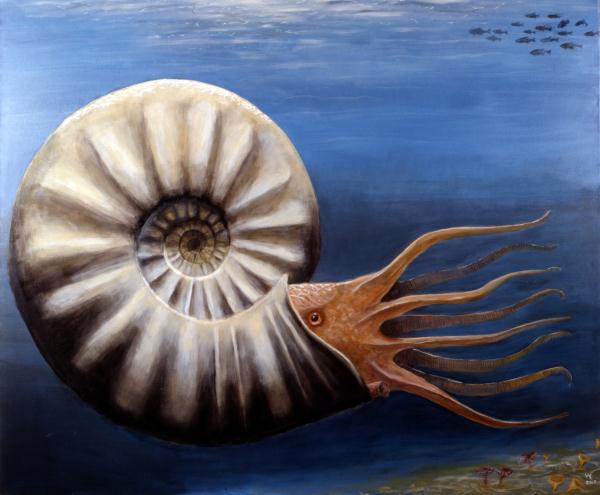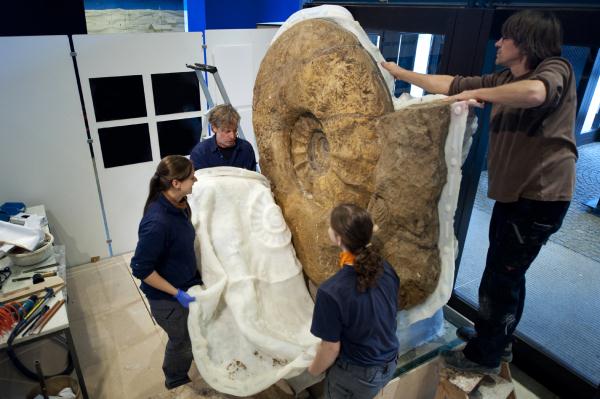[Recent Entries][Archive][Friends][User Info]
April 17th, 2013
| April 17th, 2013 | |
|---|---|
| 06:44 pm [industrialterro] [Link] |
Nostoceras Nostoceras is an extinct genus of ammonite from the Campanian stage of the Upper Cretaceous, found in the USA, England, central Europe, west Africa, and Madagascar. The etymology of the name Nostoceras comes from "nostos" meaning return and "ceros" meaning horn, named as such by Alpheus Hyatt because it bends back on itself. Nostoceras is typified by a tightly coiled helical spire on a large U shaped body chamber with the aperture, in mature individuals, nearly touching and lying underneath the spire. The initial helical whorls are covered with fine ribs and may have small spines. The U shaped body chamber has coarser ribbing and large tubercles. Periodic constrictions may be present on the phragmocone. Species may coil either to the left or to the right. Nostoceras is like Bostrychoceras in general form, except that its ribs may be flaired and the constrictions may or may not be present. Nostoceras is the type genus for the ammonite family Nostoceratidae which is included in the Turrilitoidea. The Turrilitoidea, with Nostoceras and the Nostoceratidae, are commonly included in the suborder Ancyloceratina but may instead belong in the Turrilitina, a proposed order of heteromorphs thought to have a separate derivation, though this separation does not have wide support.
Ископаемые останки (1, 2, 3, 4):
Tags: Аммониты, Вымершие беспозвоночные, Мел |
| Time | Event |
| 07:12 pm [industrialterro] [Link] |
Pachydiscus Pachydiscus is an extinct ammonite genus from the Upper Cretaceous with a world-wide distribution, and type for the desmoceratacean family Pachydiscidae. Its type is P. neubergicus. Altogether some 28 species have been described. The shell of Pachydiscus is compressed and high-whorled, with an oval or flat sided section. Ribs tend to be differentiated into short umbilical and separate ventro-lateral sets, with a smooth area between. Pachydiscus includes two subgenera, P.(Pachysiscus) from the Campanian in which the ribs persist, and P (Neodesmoceras) from the Maastrichtian in which ribs disappear early, leaving an almost smooth shell.
Ископаемые останки (1, 2, 3, 4):
Tags: Аммониты, Вымершие беспозвоночные, Мел |
| Time | Event |
| 08:31 pm [industrialterro] [Link] |
Parapuzosia Parapuzosia is an extinct genus of desmoceratid ammonites from the Cenomanian to the Campanian of Africa, Europe, and North America. They are typically very large ammonites, reaching diameters of 60 cm (2.0 ft) or more. It possess a moderately involute shell with flat or slightly rounded sides. Distinct primary and secondary ribbing can be observed in the inner whorls. Parapuzosia seppenradensis is the largest known species of ammonite. It lived during the Late Cretaceous period. A specimen found in Germany in 1895 measures 1.8 m (5.9 ft) in diameter, although the living chamber is incomplete. It is estimated that if complete, this specimen would have had a diameter of approximately 2.55 m (8.4 ft) or even 3.5 m (11 ft). The total live mass has been estimated at 1,455 kg (3,210 lb), of which the shell would constitute 705 kg (1,550 lb). Parapuzosia bradyi is a gigantic species of ammonite, reaching diameters of more than 4.5 ft (1.4 m) by 6 ft (1.8 m). It is the largest species of ammonite in North America. It had a moderately involute shell with flat sides. The inner whorls are slightly oval-shaped with prominent ribbing. They are only known from the upper layers of the Eagle Sandstone and Cody Shale formations (both Late Cretaceous).
Размеры тела в сравнении с человеком:
Ископаемые останки (1, 2, 3, 4):
Tags: Аммониты, Вымершие беспозвоночные, Мел |
| Previous Day | 2013/04/17 [Archive] |
Next Day |
















